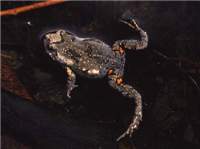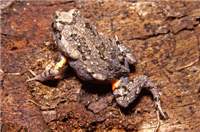Family
Myobatrachidae
Genus
Uperoleia
Species
laevigata
Threats/Control Methods - Regional
Broad-scale threats include habitat loss and modification, due to processes such as urbanisation and the introduction of alien plants. Livestock over-grazing and resulting damage to native habitats is also thought to have a negative impact on the species. Although U. laevigata may currently be common within the ACT region the introduction of diseases could be fatal to the species. Care should be taken at all times when entering frog habitats due to the risk of spreading disease, including the Chytrid fungus (chytridiomycosis). To prevent the spread of the Chytrid fungus it is important to wash your shoes before entering and after leaving frog habitats. For more information on the Chytrid fungus - Link to fact sheet http://www.deh.gov.au/biodiversity/invasive/publications/c-disease/
Local/Urban Actions
You can encourage frogs into your own backyard by including habitat features in your garden. The Ginninderra Catchment Group, Australian National University and Environment ACT have developed a guideline to help you encourage frogs into your backyard called Creating a Frog Friendly Habitat in the ACT Community.
You can also get involved in monitoring local frog populations. Frogwatch is an annual program run to monitor the presence and abundance of frogs within the ACT region. The Frogwatch program provides training for community volunteers each October, with monitoring then being undertaken by volunteers over a two week period.
For more information on Frogwatch contact:The ACT Frogwatch Coordinator, Ginninderra Catchment Group; Ph (02) 6278 3309 or email: [email protected]
Distinguishing Features
Adults range from 2.5- 3cm in length. ©Smooth© is a misnomer, as the back of this species indeed has a warty appearance, though the belly is smooth. The back colour ranges from brown to orange brown and is often a mottled mix of the two. Orange patches usually stand out both behind and in front of each thigh. The call of the species is monotonous and low pitched, described as a ©wwhhrrkkkkk©.
Common name/s
Smooth Toadlet, Eastern Gungan.
Species Call
Similar Species
The call of U. Laevigata and Crinea Parinsignifera (Plains Froglet) are often confused. The call of U. Laevigata is slightly lower and longer, however, it may take some practice to tell the two apart. Also look at the surrounding habitat. The Smooth Toadlet typically prefers dryer locations to those preferred by the Plains Froglet.
Distribution
Very common in the Canberra region, particularly in hilly areas. The species extends from south-east QLD, along the eastern edge of NSW and just crossing the border into Victoria.
Country of Origin
Australia
Survey Techniques
The most common technique for monitoring frog populations is based on call identification, with each frog species having a unique call. Frogs should not be handled without the use of sterile gloves, as their skin is very sensitive to chemicals, including sunscreen and soap.
Conservation (Pet/Pest) Status - National
Unknown
Conservation (Pet/Pest) Status - Regional
Common within the ACT region, not thought to be in decline.
LSCCES Population
In the 2004 Frogwatch census Uperoleia laevigata was detected in 27% of all sites monitored.
Associated Vegetation Community
Dry forests or woodlands, open or disturbed areas and tussock grassland.
Breeding
Calls from September through to November, with breeding occurring from October though November.
Behaviour
Males often call from hidden positions (amongst vegetation or fallen timber) as far as 10 metres away from water bodies.
Functional Group
Insectivorous
Food Species
Small moths and beetles.
Predators
May include native birds, such as the White-Faced Heron (Egretta novaehollandiae) and Intermediate Egret, and fish, including the introduced Carp, Goldfish and Trout. Introduced species such as Cats (Felis catus) and Foxes may also predate on frogs.
Interesting Fact
Despite the rough warty appearance of this frog the Latin names uperolia translates to mean smooth-backed and laevigata translates to mean smooth!
References - (reader suitability of references, P=Primary teachers, S=Secondary students, T=Tertiary students and researchers)
Books:
Barker, J., Grigg,G., Tyler, M. (1995). A Field Guide to Australian Frogs. Surry Beatty & Sons. NSW, Australia. S, TLintermans,M. & Osborne, W. (2002). Wet & Wild: A Field Guide to the Freshwater Animals of the Southern Tablelands and High Country of the ACT and NSW. Environment ACT. Canberra, Australia. S, TRobinson, M. (1993). A Field Guide to Frogs of Australia. Australian Museum/Reed books. NSW, Australia. S, TTurner, J. (2004). Frogs of Australia. Pensoft. Bulgaria. P, STyler, J. (1994). Australian Frogs: A Natural History. Reed New Holland. Australia. S, TSwan, G.(2001). Green Guide: Frogs of Australia. New Holland Publishers. Sydney, Australia. P, S
Online Publications:
Amphibian Research Centre. (2005). Available Online: http://frogs.org.au/frogs/species/Uperoleia/laevigata/ S, TAustralian Frogs Database (2005.). Uperoleia laevigata. Available Online: http://frogsaustralia.net.au/frogs/display.cfm?frog_id=102 S, TDepartment of Environment and Heritage, (2004). Chytridiomycosis Factsheet http://www.deh.gov.au/biodiversity/invasive/publications/c-disease/ S, TEnvironment ACT. (2004). Summary of results. Available online: http://www.environment.act.gov.au/Files/frogwatchoctober2004summary.pdf P, S, TEnvironment ACT. (2004). Uperleia laevigata; Smooth Teoadlet. Available online: http://www.environment.act.gov.au/Files/frogwatchoctober2004-uperleialaevigataresults.pdf S, TZoological Parks and Gardens Board. Frog Pond Checklist. Available Online: http://www.zoo.org.au/education/factsheets/amp-frog_pond_checklist.pdf P, S, TSpeare, R et al (1998). HOW TO REDUCE THE RISKS OF YOU TRANSMITTING AN INFECTIOUS AGENT BETWEEN FROGS AND BETWEEN SITES. Available Online: http://www.jcu.edu.au/school/phtm/PHTM/frogs/prevent.htm S, TZoological Parks Board N>S>W. (2005.). ASX Frog Focus. Available online: http://www.asxfrogfocus.com/ P, S (School activity program)
Researcher: Pippa Jaminon


 Top
Top Top
Top